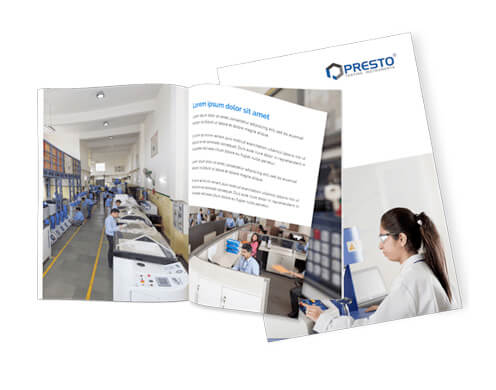What Is Tension Testing and how to perform it?
.png)
Tension testing, or tensile strength testing often regarded as a crucial testing method in materials, that encompasses the evaluation of mechanical properties by subjecting a material sample to progressively increasing tensile forces until it ruptures. This procedure aids researchers and manufacturers in comprehending the inherent structural integrity and strength of various substances under specific conditions. Presto digital tensile testing machine is highly recommended to evaluate the tensile strength of products and materials.
It is based on the CRT principle and has been equipped with an upper & lower jaw that makes it easy for the manufacturers to conduct tensile strength tests on the materials. It has been specifically designed to ensure the stability and durability of materials against tensile forces.
In this blog, we are going to discuss a brief about the Presto tensile tester and how you can easily perform tension tests on materials with the help of this lab testing instrument.
Introduction to Tension Testing
Tension testing is a type of mechanical testing that is used to determine the strength and ductility of materials. It is performed by applying an axial load to a specimen while it is supported at both ends. The load is applied gradually until the specimen fails. The results of the test are used to determine the material's yield strength, ultimate strength, and fracture toughness.
Tension testing is an important parameter for quality as it can be used to select materials for use in applications where high loads are expected. It can also be used to evaluate the performance of materials under various loading conditions. The importance of tensile strength testing in the manufacturing process is vast and provides the material’s properties like yield strength, ultimate strength, and elongation of the materials.
By performing tensile strength tests on the materials manufacturers can easily measure the durability of the materials against tensile forces. Presto offers the best quality digital tensile strength tester.
Perform tensile testing on materials with Presto digital tensile tester
Performing tensile testing on materials is a critical aspect of assessing their mechanical properties and performance. With the Presto digital tensile tester, this process becomes efficient, accurate, and reliable.
This digital tensile strength tester incorporates a special sensor, connected with a load cell. This load sensor will be capable of judging the load exerted on the stationary jaw and directly indicating the reading in kgs (in digital format).
By using this quality testing instrument, manufacturers can easily analyze the effect of low tensile rates on metals and other related materials.
Whenever you conduct tensile strength tests on the materials, then it is important for the manufacturers to prepare the specimen accurately.
Below we have listed the features and technical specifications of this quality testing equipment.
Features of Presto tensile strength tester
The Presto tensile testing machine will help the manufacturers to conduct tensile tests on the materials. Below we have listed the features of the Presto tensile testing machine:
- Advanced load sensor sensing through advanced electronics.
- Highly sensitive load sensor with linearity feature and repeatability
- Cross-head travel length: 750mm grip to grip
- Single-column rugged structure
- Safety limit switches for over-travel safety
- Hardened lead screws for frictionless movement
- Load cell calibrated by NPL-approved proving ring/dynamometers
- High accurate micro-controller based system controls
- Peak Hold facility available
- Bright LED display
- Immediate analysis of results after the test with complete accuracy & precision
- Feather touch controls
Technical specifications of Presto tensile tester
- Motor: ¼ HP Single Phase 220 / 110 V AC Supply
- Speed: 100 mm/min and 200 mm/min (Changeable through Belt & Pulley mechanism)
- Display: Digital (LED)
- Accuracy: ± 2% at Full Load (with master load)
- Grip to Grip separation: Min 25mm and Max. 700mm
With these high-end features and technical specifications, one can accurately conduct tensile strength tests on the materials and ensure the quality of test results.
Now, let us discuss some easy-to-follow steps for conducting tensile strength tests on the materials.
Easy-to-follow steps for conducting tensile strength tests on the materials
If you want to perform tensile strength tests on the materials, then you need to follow the steps mentioned below:
- You can start the test by plugging the machine into a 5 amp switch.
- Place the specimen accurately and press the RESET as well as the TARE buttons to set the value at the peak load indicator.
- Now, you can turn the rotary switch to the down direction. The lower grip will move in a lower direction and it will increase the value shown in the load indicator.
- Turn off the rotary switch when the specimen will get ruptured.
- Once the machine will stop, the display will show the load and return to zero. The elongation display will get frozen.
- You can press the memory switch on the load indicator to show the peak value.
- Note down the peak values to assess your specimen test results.
In this way, you can easily commence the test using this amazing lab testing equipment. If you need any more assistance or a FREE sample testing session for this testing equipment, then give us a call at +91 9210903903 or email us at info@prestogroup.com. We will instantly connect with you.
Author : -Gaurav Malhotra
Recent News
- Paper & Packaging Testing Instruments
- Paint, Plating & Coating Testing Instruments
- Plastic & Polymer Testing Instruments
- Environmental Testing Chambers
- PET & Preform Testing Instruments
- Color Measuring Testing Instruments
- View Entire Range Instruments

Catalogue 2023
Get information about new product launches, research, innovation and endeavors at Presto.
download Free CopyNeed more information
Connect with us for your business enquiries. Generally we respond within one or two working days.
send enquiriesContact Us
How it works
Quick quote
